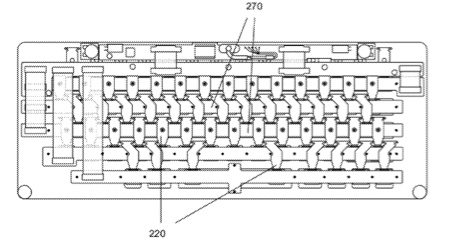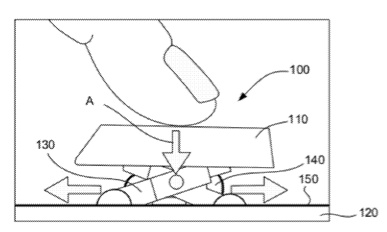An Apple patent (number 20120043191) for a single support keyboard mechanism at the U.S. Patent & Trademark Office shows that the company is working on new, thinner keyboard for its portable Macs -- and perhaps desktop Macs, as well.
A keyboard mechanism for a low-travel keyboard and methods of fabrication are described. The low-travel keyboard is suitable for a thin-profile computing device, such as a laptop computer, netbook computer, desktop computer, etc. The keyboard includes a key cap that can be formed of a variety of materials in the form of a flat slab. The key cap is attached to one end of a support lever that supports it from underneath. In one embodiment, the support lever is formed of a rigid material and is pivotally coupled with a substrate on the other end.
In another embodiment, the support lever is formed of a flexible material and is fixedly attached to the substrate on the other end. The portion of the support lever that is attached to the key cap is positioned over a metal dome that can be deformed to activate the switch circuitry of the membrane on printed circuit board underneath the dome. The inventors are Patrick Kessler, Bradley Joseph Hamel and James. J. Niu.
Here's Apple's background and summary of the invention: "The described embodiments relate generally to peripheral devices for use with computing devices and similar information processing devices. More particularly, the present embodiments relate a thin profile, aesthetically pleasing keyboard well suited for use with computing devices, and methods of assembling such thin profile, aesthetically pleasing keyboards.
"The outward appearance, as well as functionality, of a computing device and its peripheral devices is important to a user of the computing device. In particular, the outward appearance of a computing device and peripheral devices, including their design and heft, is important, as the outward appearance contributes to the overall impression that the user has of the computing device. One design challenge associated with these devices, especially with portable computing devices, generally arises from a number of conflicting design goals, including the desirability of making the device attractive, smaller, lighter, and thinner while maintaining user functionality.
"Therefore, it would be beneficial to provide a keyboard for a portable computing device that is aesthetically pleasing, yet still provides the stability for each key that users desire. It would also be beneficial to provide methods for manufacturing the keyboard having an especially aesthetic design as well as functionality for the portable computing device.
"This paper describes various embodiments that relate to systems, methods, and apparatus for providing a trapdoor keyboard mechanism for a low-travel footprint keyboard that allows the use of aesthetically pleasing key caps and also provides key stability for use in computing applications.
"According to one embodiment, a thin profile keyboard for a computing device is described. The keyboard includes a plurality of keys arranged in a plurality of rows. Each row includes a plurality of keys and the keys in a first row are offset from the keys in a second row. Each key includes a key cap and an actuator attached to a base plate. The actuator is configured to deform to activate electrical switch circuitry when it is deformed. A portion of a rigid support lever is positioned over the actuator, which can be a metal dome.
"The support lever has one end that is attached to a bottom surface of the key cap and a second end that is attached to a substrate at a pivot point. When a force is applied to the top surface of the key cap, the force causes the support lever to rotate about the pivot point, causing a bottom surface of the support lever to contact and deform the actuator. In an embodiment, the key cap can be in the form of a flat slab. An elastomeric spacer may be provided on the support lever over the metal dome such that the elastomeric spacer deforms the metal dome when the key is depressed by a user.
"The use of a single support lever allows the key cap to be simply adhered to the support lever and the support lever also reduces instability when the key is depressed by a user. As the key cap can be adhered to the support lever, intricate attachment features on the underside of the key cap are unnecessary, thereby allowing the key cap to be formed of a variety of materials, including glass and metal.
"A method of assembling at least a portion of a low-travel keyboard for a computing device is disclosed. The method can be carried out by the following operations: providing a metal dome configured to deform when depressed from above, disposing a support lever over the metal dome, and adhering a key cap to the support lever. The metal dome can activate electrical switch circuitry of the keyboard when the metal dome is deformed. The support lever is coupled with a substrate at a point on a first end of the support lever.
"The bottom of the key cap is adhered to a top surface of the second end of the support lever, which is positioned over the metal dome to deform the dome when depressed from above. In an embodiment, the support lever is formed of a rigid material and is pivotally coupled to the substrate such that the support lever deforms the metal dome when the support lever is depressed from above, as the support lever rotates slightly about the pivot point where it is coupled to the substrate. In another embodiment, the support lever is formed of a flexible material and fixedly coupled to the substrate on one end."














